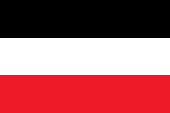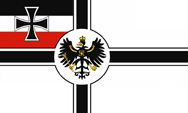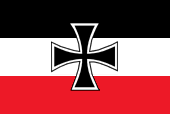mobile View, to the German Version tap the flag


- 1866–1871
- North German Confederation
- Monarchial federation of German states
• The North German Confederation
• Flags
• Origin of the black-white-red Flag
• Coat of Arms
• Numbers and Facts
• Map
• History
As the war of Prussia and Austria and their respective allies on the 3rd of July in 1866 it the battle near Koeniggraetz was determined in favor of Prussia, end this war with the peace of Prague on 23rd of August in 1866. The initiative for the unification of the empire was with this fact swaped to Prussia. This means the preference of a so named "small German" solution, what means the creation of a all-german national state under exclusion of Austria. The Prussian premier Otto von Bismarck was ambitioned to create such a state shape since August 1866, to begin with the 17 German states, wich were participated as allies in the war against Austria. After peace treaties joined the North German Federation even Reuß of older lineage, Saxony and Saxony-Meiningen, and partially (only the northern part of the land) even Hesse-Darmstadt. The constitution of the confederation came into force on the 1st of July in 1867. President of the confederation became the Prussian king (Wilhelm I.). He had the supreme command over the federal army and determines solely over the mutual foreign affairs. The uppermost government organ was the Bundesrat (federal council), as mutual agency of all membering states, which lead the by Prussia to nominate federal chancellor (Otto von Bismarck). Elections determined about the assembly of the Reichstag (empire's council), which was the legislature together with the Bundesrat. This constitution was the basis for the constitution of the German Empire of 1871.
Source: Volker Preuß


Federal and merchant flag,
ratio = 2:3,
Source, by: Flags of the World






War flag,
ratio = 3:5,
Hier klicken für mehr Informationen!




Naval jack,
ratio = 2:3,
Source, by: Flags of the World











The colors of the flag of the North German Confederation are black, white and red. This combination of colors was formed in the year 1867 by combination of the colors of Prussia (black and white) with the colors of the Hanseatic Towns Hamburg, Bremen and Lübeck (red and white). This flag was invented as flag for the North German Confederation not as national flag, because finally the Condederation represented no nation, but still an alliance of states. The black-white-red flag was determined for the trade fleet of the North German Confederation, initially even for the navy, too. Because only Prussia and the Hanseatic Towns had an greater number of trade- or warships, explains itself, why the colors black, white and red were sufficient for the representation of the North German Confederation in the oceans. About the origin of the combination of the colors black, white and red there are still further theories, which however
have no foundation:
• This combination of colors should came into being by the combination of the colors of Prussia with the colors of the old Electorate of Brandenburg
• Every single color, if black, white or red should have their own meaning. In this way should black stand for the dark past, white for the shining future, and the red should stand for the in the fight for the national unity fallen.
The war flag and even the jack of the warships show an Iron Cross. The Iron Cross is a military distinction from the liberation wars. Since his foundation in the year 1813 it was avarded right from the beginning without consideration of the military or social rank, and is therewith a kind of a people's order, which, even in the times after the liberation wars, inspired the idea of a ethnic-national resistance against foreign determination and for a free and indivisible nation. At the designing of the order stood the flag of Prussia from the 18th century for model, and for her was the pattern the cross of the Teutonic Order (teutonic knights) from the 15th century. The Iron Cross was endowed again in the year 1870 in context with the military quarrels between the North German Confederation and the Empire of France (German-French war).
Source: Jürgen Kaltschmitt


Coat of arms of the North German Confederation

The North German Confederation includes initially the following 18 states:
• Kingdom of Prussia
• Grand Duchy of Mecklenburg-Schwerin
• Grand Duchy of Mecklenburg-Strelitz
• Grand Duchy of Oldenburg
• Grand Duchy of Saxony-Weimar-Eisenach
• Duchy of Brunswick
• Duchy of Saxony-Coburg-Gotha
• Duchy of Saxony-Altenburg
• Duchy of Anhalt
• Principality of Waldeck
• Principality of Lippe (-Detmold)
• Principality of Schaumburg-Lippe
• Principality of Schwarzburg-Rudolstadt
• Principality of Schwarzburg-Sondershausen
• Principality of Reuss Junior Line
• Free and Hanseatic Town Luebeck
• Free and Hanseatic Town Bremen
• Free and Hanseatic Town Hamburg
After the "peace of Prague" must the following states join the North German Confederation:
• Kingdom of Saxony
• Grande Duchy of Hessen (Hessen-Darmstadt)
• Duchy of Saxony-Meiningen
• Principality of Reuss Senior Line
The following states got annexed by Prussia and incorporated as provinces after the "peace of Prague":
• Kingdom of Hanover
• Duchy of Nassau
• Electorate of Hesse (Hessen-Kassel)
• Landgraviate of Hesse-Homburg
• Free Town Frankfurt


Source: Ziegelbrenner [CC BY-SA]
The map shows the North German Confederation within a red border.

1866 · Prussian-Austrian War, or German War or Fratricidal War, defeat of Austria
and its allies against Prussia and its allies,
Prussia acquires Schleswig-Holstein,
Hanover, Hesse-Kassel and
Nassau, smashing of the German Confederation and
Prussia forces the establishment of the
North German Confederation
1866 · establishment of the North German Confederation
1st of July in 1867 · the North German Confederation
gets a constitution, it becomes a federal state under the leadership of
Prussia, chancellor becomes Otto von Bismarck
1870/1871 · Franco-German War
18th of January in 1871 · proclamation of the German Empire
at Versailles, the king of Prussia
was proclaimed as German Emperor, the constitution of the
North German Confederation becomes transmitted with
a few changes to the German Empire
Source: Wikipedia (D),
Atlas zur Geschichte,
Discovery '97,
Volker Preuß













![]()













